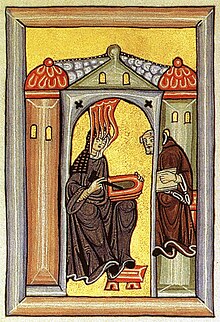Private disclosure

A private revelation is the name of the Roman Catholic Church for a revelation of Christ , Mary or an angel to a person as a private person, which is defined as non-binding for the believers, even if not without meaning.
Church recognition
In the Roman Catholic Church , a private revelation can be "recognized", but this only means that in the sense of a nihil obstat nothing was found in it that corresponds to scripture or church tradition - according to the Catholic understanding, these are the sources of the truth of faith - im Contradiction. So no statement is made as to whether the respective private revelation is actually of supernatural origin; this is rather left to the belief of the individual.
On February 24, 1978 the Vatican Congregation for the Doctrine of the Faith established norms for the ecclesiastical evaluation of private revelations.
Appearances, visions, messages
In terms of number, most of the more recent private revelations since the 18th century have taken place in the context of Marian apparitions ; B. in Lourdes , La Salette , Fatima or at María von Ágreda .
Not Marian private revelations, which often angels or unspecified voices accompanying as the seer or visions explanatory protagonists occur, some with Jesus Christ , the Holy Spirit or a particular saint are identified, can be found in the experiences and reports of many mystics and Visionaries like Hildegard von Bingen , Angela von Foligno , Jeanne d'Arc , Teresa von Ávila , Anna Katharina Emmerick , Therese Neumann or Faustyna Kowalska . Since the theological term private revelation is of more recent origin and in the Middle Ages no conceptual distinction was made between “official” (ecclesiastical or biblical) and “private” revelation, such older mystical reports are rarely associated with the term today, although the Experience does not seem to fundamentally differentiate. They also fall under this definition in the ecclesiastical assessment.
Certain difficulties for the question of the liability of faith in the authenticity of "private" revelations or messages arise when the seer or relevant media from the Church by canonization confirms and teachers of the church have been raised, bringing the traditions to such saints a quasi " official “character received. The belief required by Catholics in the correctness of the Church's decision, however, relates to the fundamental judgment of the person and their holiness , but not to all details of their mystical or supernatural knowledge, miracles , private teachings or messages.
Individual evidence
- ↑ Norms for the Procedure for Judging Suspected Apparitions and Revelations on the Holy See's website
literature
- Ramon de Luca: Real or Fake? The Church's criteria for differentiating private revelations , Verax-Verlag, Müstair / GR 1998, ISBN 3-909065-03-1 .
- Prosper Lambertini / Benedict XIV .: De beatificatione et canonizatione servorum Dei , 1734–1738.
- RP Joannis Martinez de Ripalda: De ente supernaturali disputationes theologicae , Ed. Parisiis 1871–1873, Tomus VII, (Disputatio VII: De Revelatione Privata).
- Card. Juan de Lugo: Disputationes scholasticae et morales , Ed. Parisiis 1891-1894, Tomus I De virtude fidei divinae
- Johannes B. Scaramelli: Rules for differentiating the spirits , Kral-Verlag, Abensberg 1974.
- Giovanni Battista Scaramelli: Accompanying in the mystical experience , Echter-Verlag, Würzburg 2001, ISBN 3-429-02295-9 .
- Patrick Diemling : New Revelations. Religious studies perspectives on texts and media of the 19th and 20th centuries, dissertation, Potsdam, Universitätsverlag 2012; ISBN 978-3-86956-209-4 .